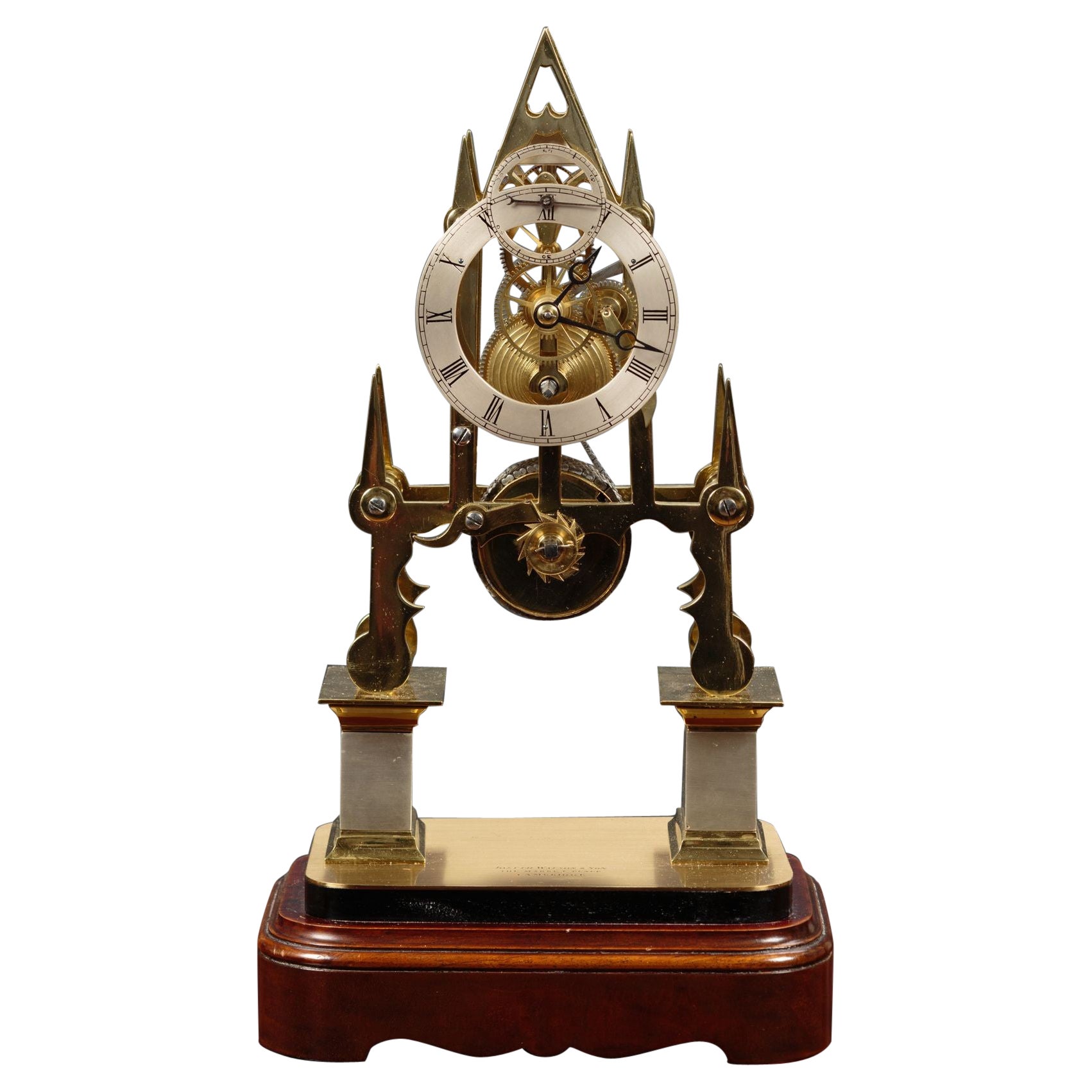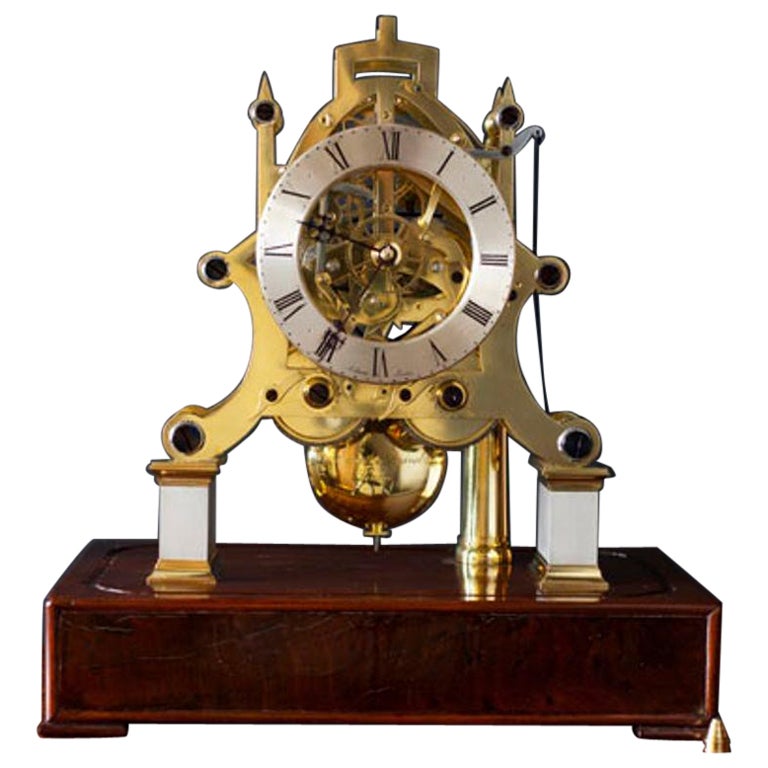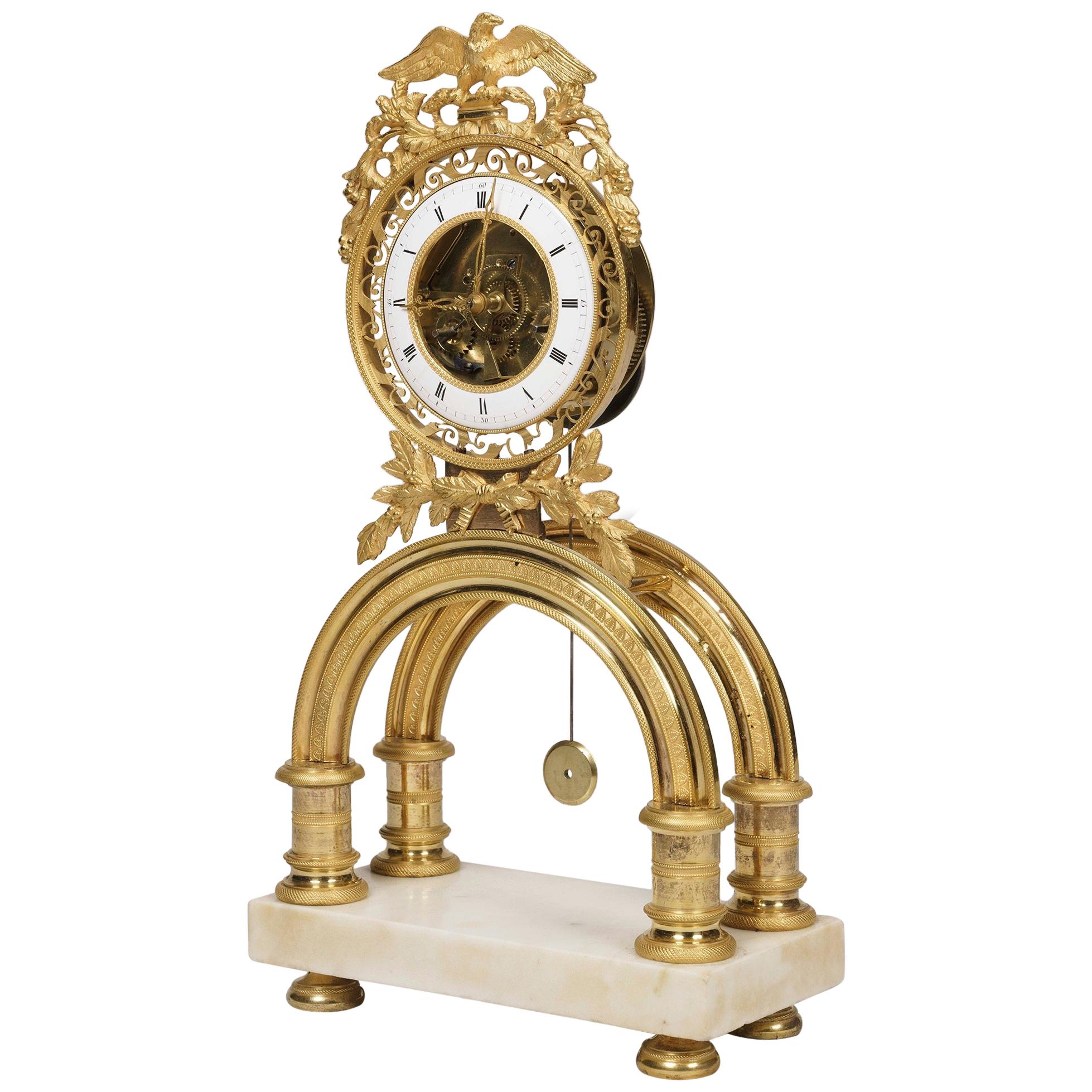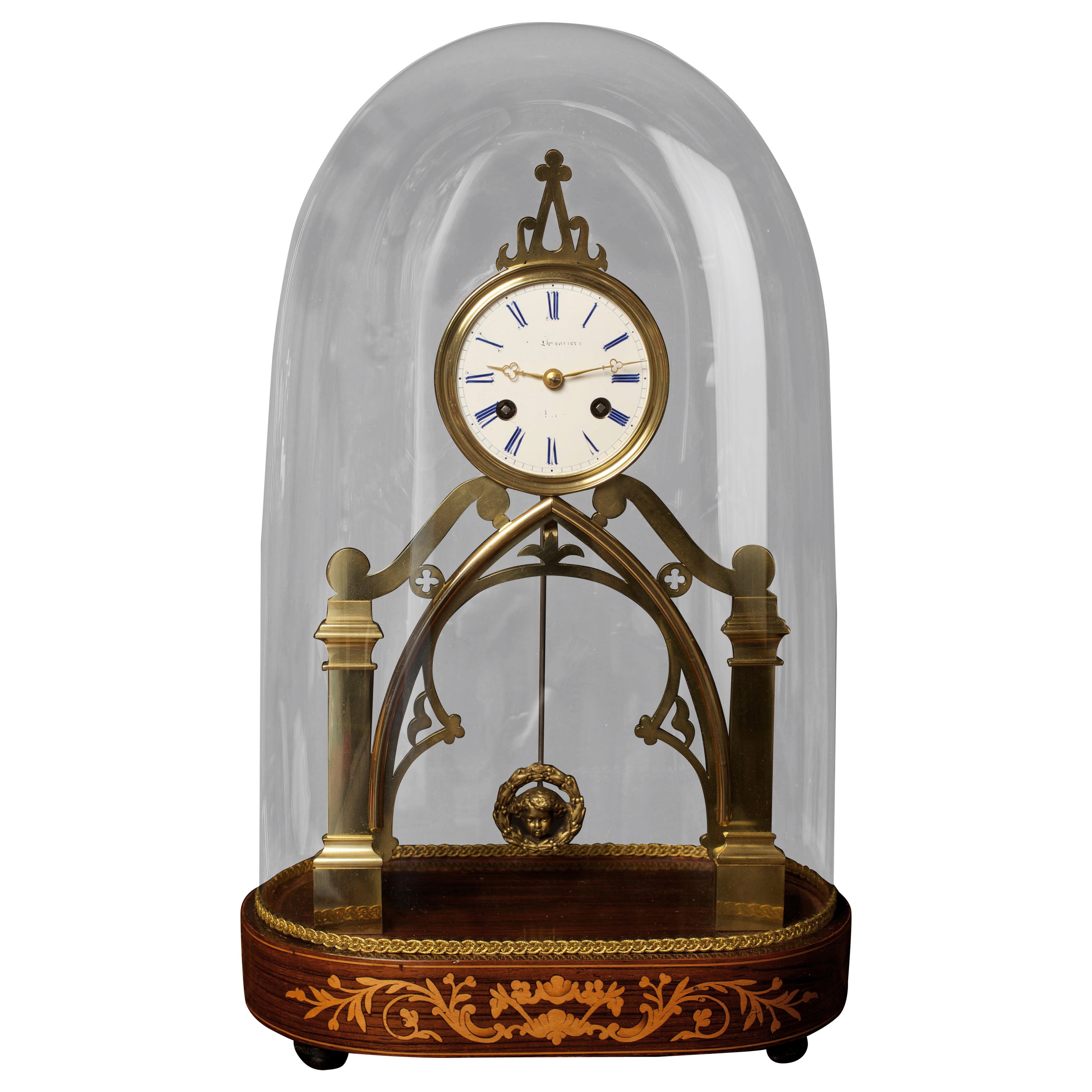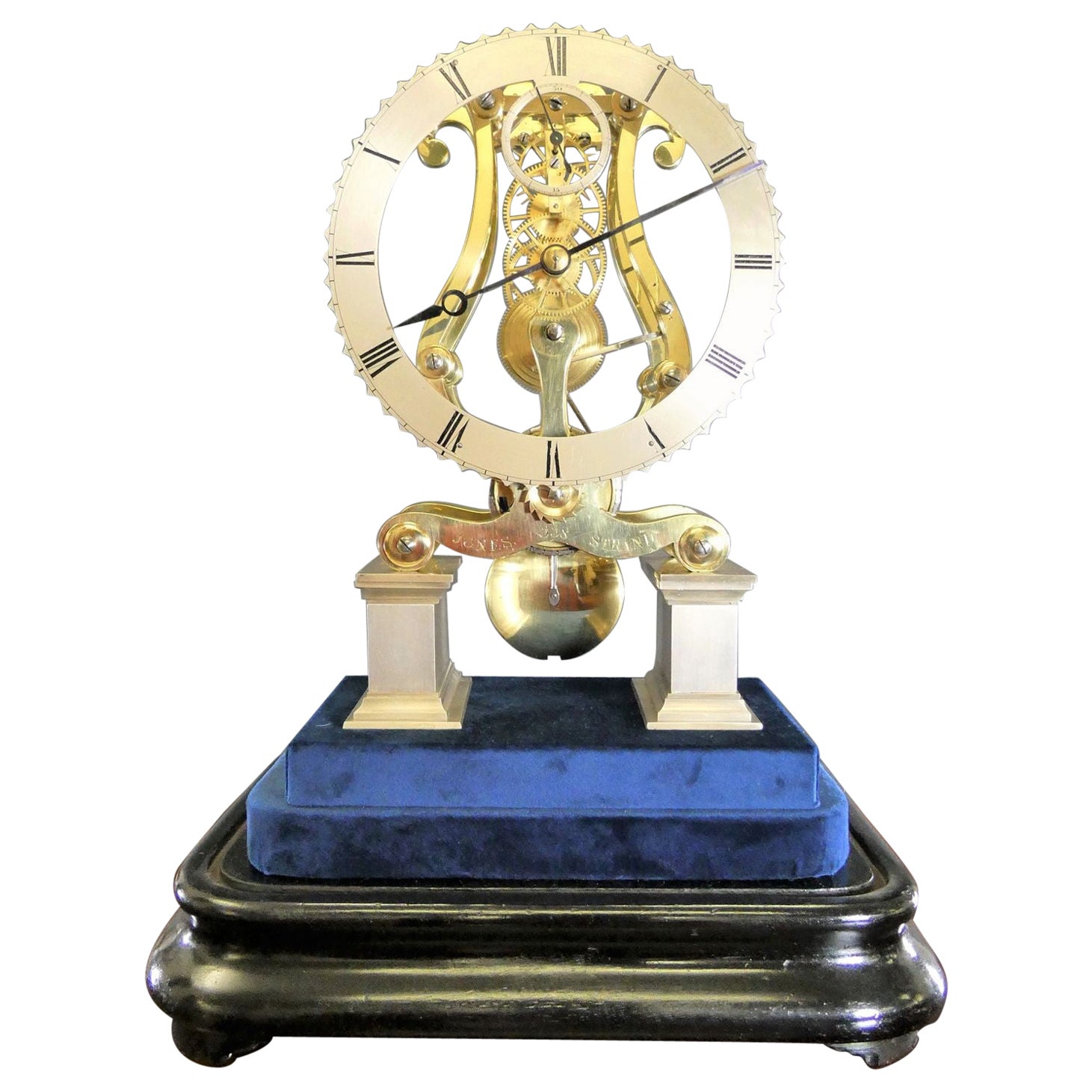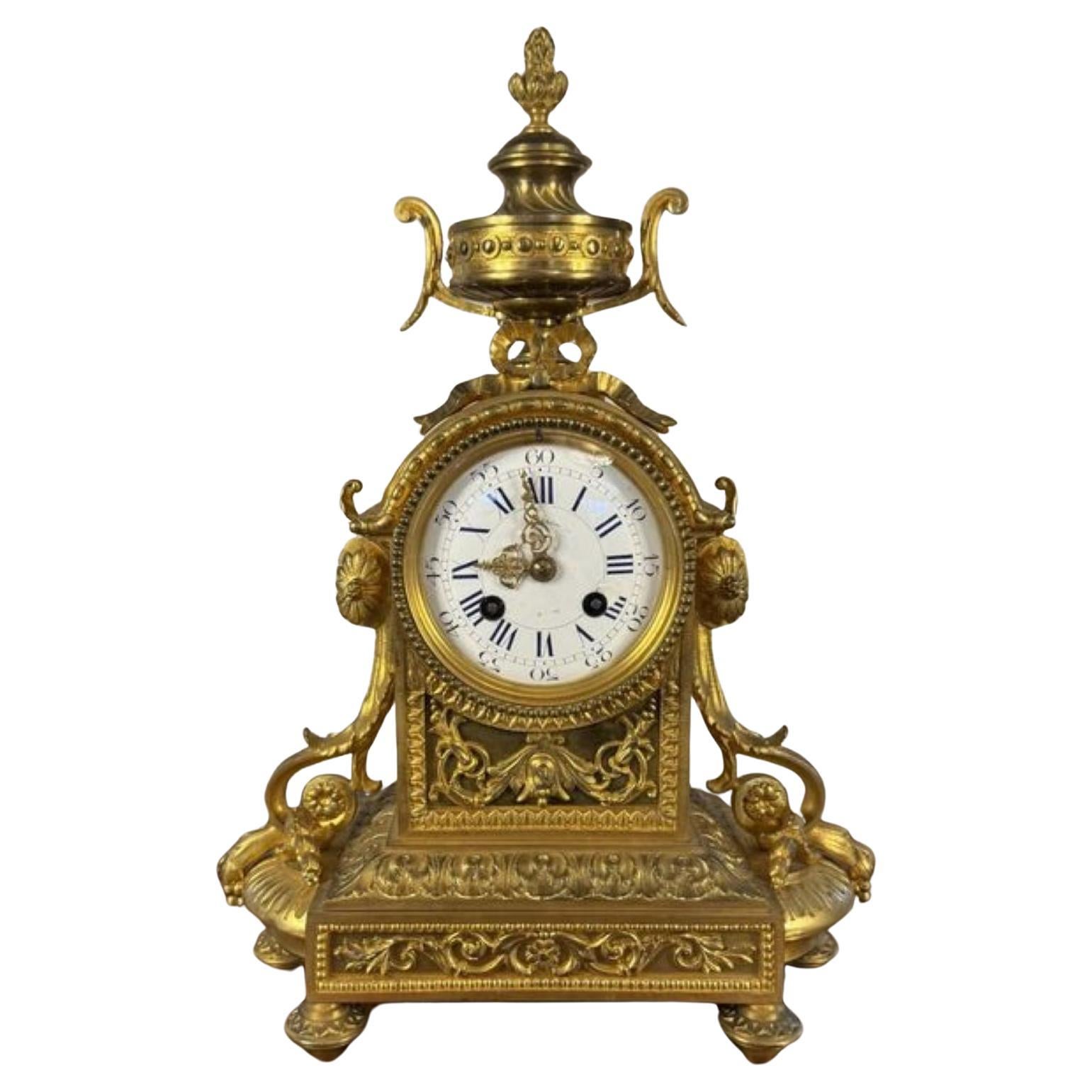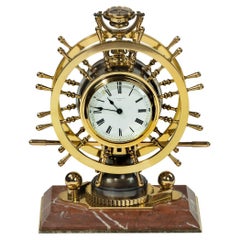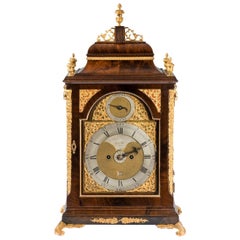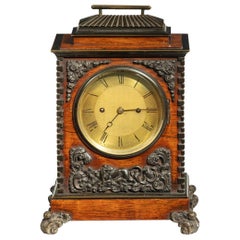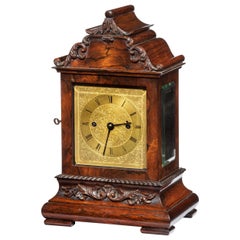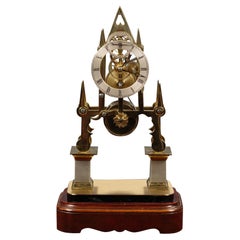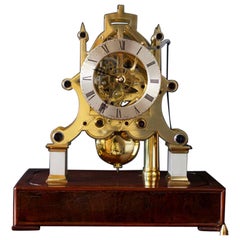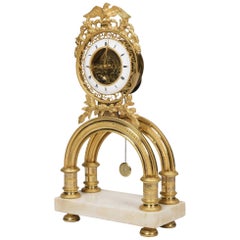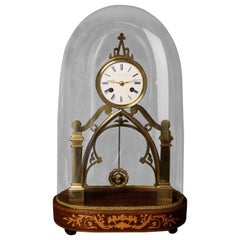Items Similar to A very fine mid Victorian skeleton clock by Johnston of London
Want more images or videos?
Request additional images or videos from the seller
1 of 11
A very fine mid Victorian skeleton clock by Johnston of London
$11,750.84
£8,700
€10,133.09
CA$16,436.49
A$17,986.89
CHF 9,433.30
MX$214,981.63
NOK 119,047.77
SEK 111,057.20
DKK 75,675.42
About the Item
A very fine mid Victorian skeleton clock by Johnston of London, of large rectangular form comprising two openwork arabesque panels parti A very fine mid Victorian skeleton clock by Johnston of London, of large rectangular form comprising two openwork arabesque panels partially shielding the fusée bell striking movement, the polished scroll frame raised on shaped turned pillars, the foliate scrolled silvered and engraved dial with Roman numerals joined with delicate thistle motifs, housed in its integrated glazed brass case applied with a silvered maker’s labels stating ‘Johnston, 2 Elm Street, Gray’s Inn Lane, London’. English, circa 1852.
Provenance: W. B. 1852 thence
C. B. 1900 thence
E. M. 1902
John Johnston is a rare maker and there is a certain amount of confusion about his business, with some sources stating that a David Graeme Johnston traded at 2 Elm Street until circa 1830 before being succeeded by his widow. However, the 1871 census reveals a John Johnston, “watch making, repairing”, then aged 44, registered at 2 Elm Street with his wife Matilda, aged 42. In the 1881 census, the couple were both still alive though confusingly had only aged by 6 years in the intervening 10 year period, being listed as 50 and 48 years old respectively. Matilda survived her husband and died in 1910. In Britten’s Former Clock & Watchmakers and Their Work, published in 1894, he listed “J. Johnston” as operating from the correct 2 Elm Street address in 1835.
There are many prominent Johnston watch and clockmakers listed in Scotland and it is highly likely that John Johnston was descended from one of these families. Few surviving clocks and watches made by John Johnston are recorded but those that do all appear to be very high quality. Elm Street was located right in the centre of the historic clockmaking area in London and it is likely that much of Johnston’s work was carried out on behalf of retailers and other makers who then sold the work on as their own – this was common practice in the trade and remains the case today.
ally shielding the fusée bell striking movement, the polished scroll frame raised on shaped turned pillars, the foliate scrolled silvered and engraved dial with Roman numerals joined with delicate thistle motifs, housed in its integrated glazed brass case applied with a silvered maker’s labels stating ‘Johnston, 2 Elm Street, Gray’s Inn Lane, London’. English, circa 1852.
Provenance: W. B. 1852 thence
C. B. 1900 thence
E. M. 1902
John Johnston is a rare maker and there is a certain amount of confusion about his business, with some sources stating that a David Graeme Johnston traded at 2 Elm Street until circa 1830 before being succeeded by his widow. However, the 1871 census reveals a John Johnston, “watch making, repairing”, then aged 44, registered at 2 Elm Street with his wife Matilda, aged 42. In the 1881 census, the couple were both still alive though confusingly had only aged by 6 years in the intervening 10 year period, being listed as 50 and 48 years old respectively. Matilda survived her husband and died in 1910. In Britten’s Former Clock & Watchmakers and Their Work, published in 1894, he listed “J. Johnston” as operating from the correct 2 Elm Street address in 1835.
There are many prominent Johnston watch and clockmakers listed in Scotland and it is highly likely that John Johnston was descended from one of these families. Few surviving clocks and watches made by John Johnston are recorded but those that do all appear to be very high quality. Elm Street was located right in the centre of the historic clockmaking area in London and it is likely that much of Johnston’s work was carried out on behalf of retailers and other makers who then sold the work on as their own – this was common practice in the trade and remains the case today.
- Creator:John Johnston (Clockmaker)
- Dimensions:Height: 15.5 in (39.37 cm)Width: 10.75 in (27.31 cm)Depth: 6.5 in (16.51 cm)
- Style:Victorian (Of the Period)
- Materials and Techniques:
- Place of Origin:
- Period:
- Date of Manufacture:1852
- Condition:Wear consistent with age and use.
- Seller Location:Lymington, GB
- Reference Number:1stDibs: LU973042600142
About the Seller
5.0
Recognized Seller
These prestigious sellers are industry leaders and represent the highest echelon for item quality and design.
Established in 1982
1stDibs seller since 2013
138 sales on 1stDibs
Typical response time: <1 hour
Associations
LAPADA - The Association of Arts & Antiques Dealers
- ShippingRetrieving quote...Shipping from: Lymington, United Kingdom
- Return Policy
More From This Seller
View AllVictorian Brass Novelty Clock by Elkington & Co
By Elkington & Co.
Located in Lymington, Hampshire
A Victorian brass novelty clock by Elkington & Co., in the form of a double steering-wheel, one wheel enclosing a clock and the other a barometer, with ...
Category
Antique 1880s English Victorian Mantel Clocks
Materials
Brass
Bracket Alarm Clock by John Taylor
Located in Lymington, Hampshire
A fine mahogany bracket alarm clock by John Taylor, the rectangular case enclosing an arched gilt and steel face with a clock-face, a silent/strike...
Category
Antique 1780s English Mantel Clocks
Materials
Mahogany
William IV Rosewood and Bronze Bracket Clock by Frodsham 185 & Baker
Located in Lymington, Hampshire
William IV rosewood and bronze bracket clock by Frodsham 185 & Baker, the brass eight-day movement striking on a bell, the backplate numbered ‘292’, the circular brass dial with roman numerals and an engine turned centre, signed ‘Frodsham & Baker Gracechurch St. London‘, in an architectural case with applied panels, the front decorated with a lion and foliage, the corners with quoins, the sides with scrolling leaves and palmettes, with a fan pagoda top with a retractable oriental gateway handle, on leaf scroll feet, with pendulum, winding key and case key. English, circa 1830.
William Frodsham was an established London clockmaker. One of his sons, John Frodsham (1785-1849), went into partnership with Baker to form ‘Frodsham and Baker’ in 1809’. They were chronometer makers to the Admiralty and also made wall...
Category
Antique 1830s English Mantel Clocks
Materials
Bronze
Late William IV Rosewood Bracket Clock by French, Royal Exchange, London
Located in Lymington, Hampshire
The case carved in high relief with scrolls and an acanthus leaf finial, the gilt face finely chased with further scrolls and signed on the dial, with a discreet/silent lever above t...
Category
Antique 1830s English Mantel Clocks
Materials
Rosewood
A late Louis XVI marble and ormolu portico clock
Located in Lymington, Hampshire
A late Louis XVI marble and ormolu portico clock, comprising a central drum-shaped clock with a sunburst pendulum, surmounted by the gilded figure of Athena wearing armour with a plu...
Category
Antique Late 18th Century French Louis XVI Mantel Clocks
Materials
Marble, Ormolu
Late 19th Century French Novelty ‘Quarterdeck’ Mantel Clock by Guilmet, Paris
By Andre Romain Guilmet
Located in Lymington, Hampshire
A late 19th century French gilt-brass and steel novelty ‘quarterdeck’ mantel clock by Guilmet, Paris, the eight-day gong striking movement with anchor escapement, circular gilt Roman...
Category
Antique 19th Century French Mantel Clocks
Materials
Brass
You May Also Like
Early Victorian English Skeleton Clock by Joseph Watson & Son, Cambridge
Located in Norwich, GB
Early Victorian Skeleton Clock by Joseph Watson & Son, Cambridge
Eight day chain fusee movement with fine wheelwork set between steeple sh...
Category
Antique 1840s English Early Victorian Mantel Clocks
Materials
Brass
William IV Double Fusee Skeleton Clock by A. Stewart, London
Located in Norwich, GB
A William IV Skeleton clock of fine quality with two massive scroll plates sitting on rectangular, silvered plinths and standing on a mahogany base with block feet.
Eight day doubl...
Category
Antique 1830s English William IV Mantel Clocks
Materials
Brass
19th Century French Skeleton Clock of Ormolu and Marble from Directoire Period
Located in London, GB
A symbolic skeleton clock from the French Directoire period.
A rectangular Carrara marble plinth with bronze toupie feet with knurled decoration supports an ormolu 'arc-de-ciel', wi...
Category
Antique Early 19th Century French Directoire Mantel Clocks
Materials
Carrara Marble, Ormolu, Bronze
French Skeleton Mantel Clock
Located in Norwich, GB
French Skeleton clock with Gothic style brass frame standing on a marquetry inlaid rosewood base with bun feet.
Cherubs head pendulum bob, enamel dia...
Category
Antique 1850s French Napoleon III Mantel Clocks
Materials
Brass
Georgian Chain Fusee Skeleton Clock by Jones, Strand
Located in Norwich, GB
Georgian Skeleton Clock by Jones, The Strand, London
Georgian skeleton clock standing on an ebonised stepped base lined with blue velvet and original square glass dome.
Lyre ...
Category
Antique 1820s English Mantel Clocks
Materials
Brass
Fantastic quality antique Victorian French mantle clock
Located in Ipswich, GB
Fantastic quality antique Victorian French mantle clock, having a quality antique Victorian French mantle clock with a French eight day movement striking on bell, with circular ename...
Category
Antique Early 19th Century French Early Victorian Mantel Clocks
Materials
Brass
More Ways To Browse
London Mid Century
Johns Fine Furniture
Watch Repair
London Brass Clocks
Antique Skeleton Clock
Skeleton Mantel Clocks
Pillar And Scroll
J Johnston
Victorian Skeleton Clock
Victorian Glass Skeleton Clocks
Psyche Bronze 19th Century French
Antique Clock Finials
Antique Clock Pendulum Clocks
French 1890 Mantel Clock
Antique Clock Collection
Brass Clock Set
Antique Copper Rings
Bird Clock
